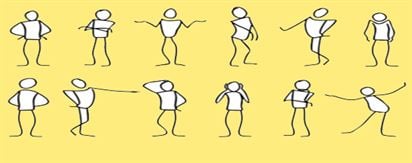
Body language during an interview Body language is a very powerful tool. We had body language before we had speech, and apparently, 80 per cent of what you understand in a conversation is read through the body, not the words- Deborah Bull
Correctly so! Body language is a very important part of who we are. Consciously and unconsciously there are lots of messages that a person has the ability to portray through one’s body language. What is often regarded as a part of the non-verbal communication, body language emits a lot of signal knowingly and unknowingly. So it is important that one learns to control and be in charge of what kind of message is sent across to the other person. The thing with body language is that sometimes it can land you in trouble if you are not careful about the way you choose to handle it. Body language experts often interpret touching or rubbing of nose as a sign of lying. So if you are doing this often in an interview the interviewer might not consider you as a strong candidate for the job. While we would be discussing on how to hold yourself and check your body language during an interview, now this, that the ability to do so in general life will also get you far. A controlled and correct body language will not only make you look confident but it will also build your own confidence level. First impressions This might be one the biggest clichés around but know this that first impression is the last impression. The interview can sometimes begin much before you enter that room of the interviewer. You never know who judges you for what you are doing before entering the final room. You should be confident at all times and hold that head high and be as calm as possible. Be prepared and keep your documents neatly stacked in one folio or folder. Be good Most experts will tell you that even the receptionist that the place you’re interviewing can have a lasting effect on your interview. Some hirers will ask about their receptionists take on you so make sure that you are cordial to all and make people around you comfortable as well. Also if possible try and sit facing in the direction where you think your interviewer will come from. It will make the greeting more graceful. Balance the beam When you are in the waiting room, waiting for your turn make sure you sit in an upright position with your shoulders upright and making sure your back doesn’t hunch back or slouch. This will not only make you seem confident but also make you seem more assertive. Don’t overdo it; no one likes a pompous and overconfident person as well. Make sure that all your documents, folios or folders are neatly tucked on your lap so that you are not left fiddling with stuff on getting up. This will make you seem like a clumsy and disorganized person. During the interview The most important part now- the interview. Nothing is as important as knowing how to conduct yourself during the interview. First of all make sure that any bag or folders apart from the ones which are to be share with the interviewer are not kept in your lap. It is a hindrance between your interviewer and you and will come across as a barrier around you. During the interview be upright and never slouch. Leaning forward can also make you seem closed off and slouching is a sign of disinterest. Make sure that while gesturing, your hands are always above the desk and below the collarbone. If there is no table then make sure your gesturing is kept around your navel as body language experts claim it to be the ‘truth plane’. Gesturing from here communicates that you're centered, controlled and calm and any higher would make you seem frantic. It is advised you sit a foot away from the table. Do not cross your legs or idly shake one over the other. Not only is it distracting but also shows how uncomfortable you are. The goodbyes Once the interview is over, calmly collect all your belongings and rise slickly. During all this do not forget to smile; I’m sure no one wants to be remembered as the grumpy one. Make sure that your goodbye handshake is as calm and firm as the one that you did while entering. Do not forget to shake hands with the person who had guided you towards the interview, the assistant or the receptionist, especially if they are in the interview room. Do not try to get any cues on how you think your interview went. If your interviewer is trained enough to read your body language he’d be trained enough not to give away any hints just yet.